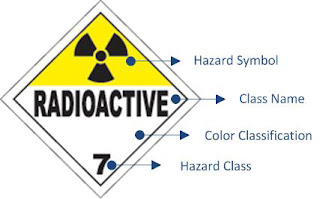One concern that has been raised by the public is that terrorists will escalate from explosive or shrapnel bombs to bombs with hidden dangers as well as physical ones. In fact, one of the major worries in the aftermath of the recent Boston Marathon bombings was whether or not the shrapnel bombs were also radiological dispersion devices (RDDs) also known as dirty bombs.
 |
| Explosives Plus an Easily Dispersed Radioactive Source |
First, an overview of dirty bombs and how they work.
Dirty bombs go a step beyond traditional explosives and add a radioactive component in the form of pellets or powder to the mix. One thing to note is that devices containing materials classified as radioactive does not equate them to a nuclear or atomic bomb. The violent fission reactions found in atomic bombs are not present in RDDs. Dirty bombs are meant to foment chaos and disruption instead of mass destruction. Terrorists count on public misinformation to help create further panic in a crisis situation.
When an RDD explodes, it coats everything nearby including people and objects with radioactive particles which can travel beyond the initial blast radius. Because of this, in addition to immediate contamination, secondary contamination can occur well beyond the radius of the blast.
What should I do if I find myself within the blast radius of one of these bombs?
First of all, don’t panic. While exposure to the types of radioactive material that would be found in these bombs could be an issue eventually if not properly cleaned up, the strength of the material used is not going to cause immediate radiation sickness, cell damage, or instant cell mutation1.
Because radiation cannot be felt or seen, the cautious thing to do is assume that there was a radioactive component to the bomb and respond accordingly. The Nuclear Energy Institute (NEI) has listed some general guidelines to follow if you find yourself in this situation and you are not seriously injured by the initial explosion.
- Leave the immediate area on foot—do not take public transportation.
- Go inside the nearest building. Seeking immediate shelter will reduce exposure to any radioactive material at the scene of the explosion.
- Remove clothing as soon as possible and seal it inside a plastic bag. Save the clothing so that emergency response personnel can test it. Removing clothing will eliminate 90 percent of the radioactive contamination, according to the Centers for Disease Control and Prevention.
- Take a shower or wash yourself as completely as possible. This will reduce the amount of radioactive contamination.
- Seek more information from emergency response personnel who respond to the explosion.
What if I live nearby? Should I evacuate or stay where I am?
If emergency responders have not made their way to your area, unless your building is damaged, it is recommended that you stay put. Many of the radioactive materials that are likely to be used in dirty bombs have a short half-life and decay quickly. They are also unlikely to penetrate building walls. If you are instructed to or choose to shelter where you are in the absence of instruction, it is recommended that you turn off your heating/air conditioning and any other device that draws air from the outside temporarily. As the situation becomes more organized, you should be able to get feedback from emergency personal by radio or in person for instructions on how to proceed.
In a particular event, who determines whether or not a bomb contains radioactive material?
The National Guard has a Civil Support Team (CST) whose members are deployed to most major events. Included in the gear that they have on hand is a portable radiation detector. As these individuals scan the area for various threats, they will determine whether or not radioactive material was mixed with the explosives. The CSTs will then alert the nearby population with the results of their testing.
 |
| Portable Radiation Detector with a Belt Clip |
The best defense against these kinds of terrorist actions is to be informed. Knowing what to do if you find yourself in this situation robs them of their goal to spread chaos and fear. Better yet, spread the knowledge you’ve gained and together we can stand against those that want to harm us and take away our freedoms.
___________________________________________________________________
D-tect Systems is a supplier of advanced radiation and chemical detection equipment sold around the world. www.dtectsystems.com1 Information provided by NEI
References:
Steps for Public Safety Against a ‘Dirty Bomb’, Nuclear Energy Institute
http://www.nei.org/resourcesandstats/Documentlibrary/Safety-and-Security/factsheet/publicsafetystepsagainstadirtybomb
Boston Marathon Bombings Raises New Concerns of “Dirty Bombs,” Emergency Film Group
http://www.efilmgroup.com/emergency-film-blog/boston-marathon-bombings-raises-new-concerns-of-dirty-bombs/
Dirty Bomb, National Terror Alert Response Center
http://www.nationalterroralert.com/dirtybomb/






